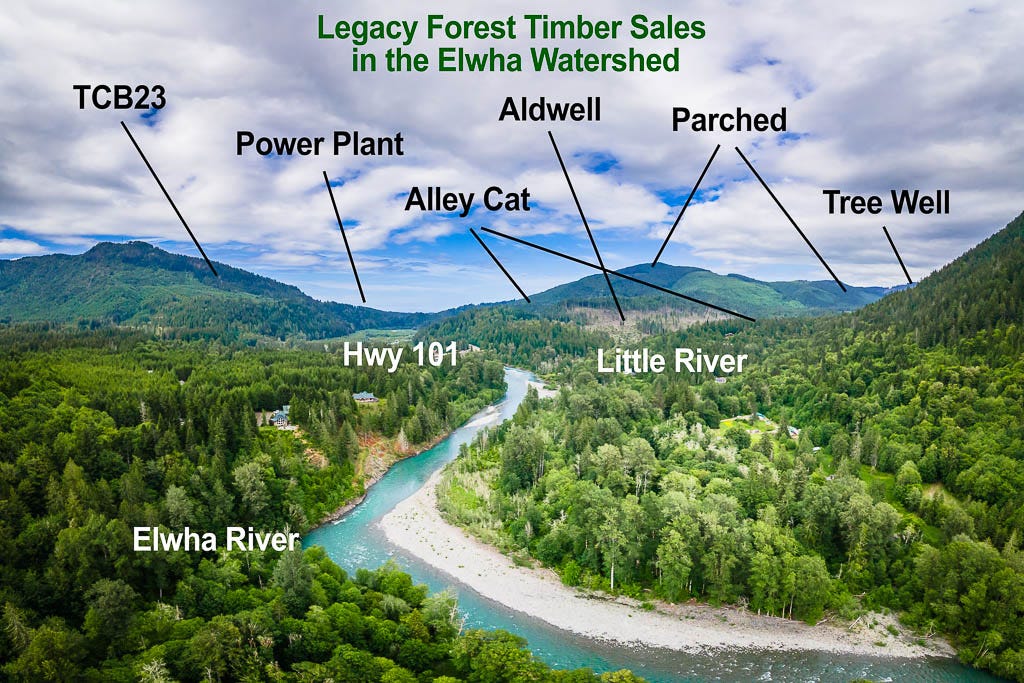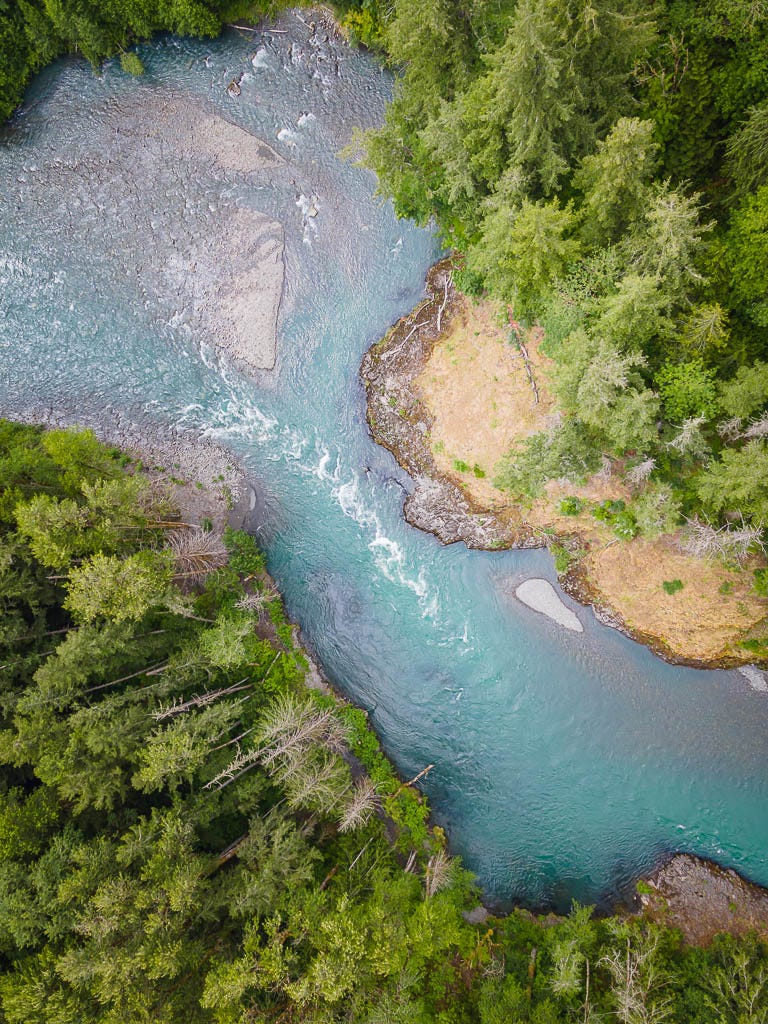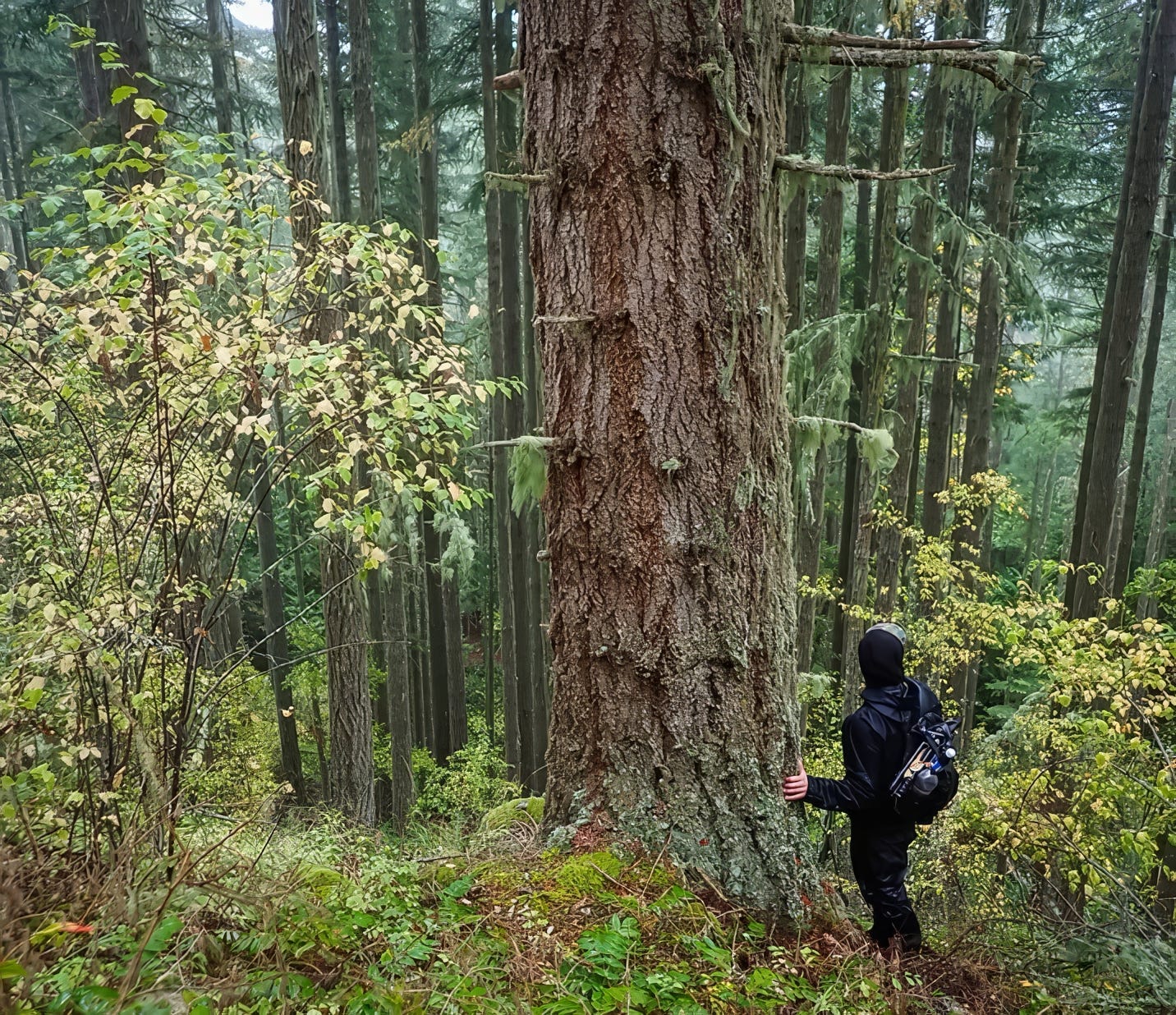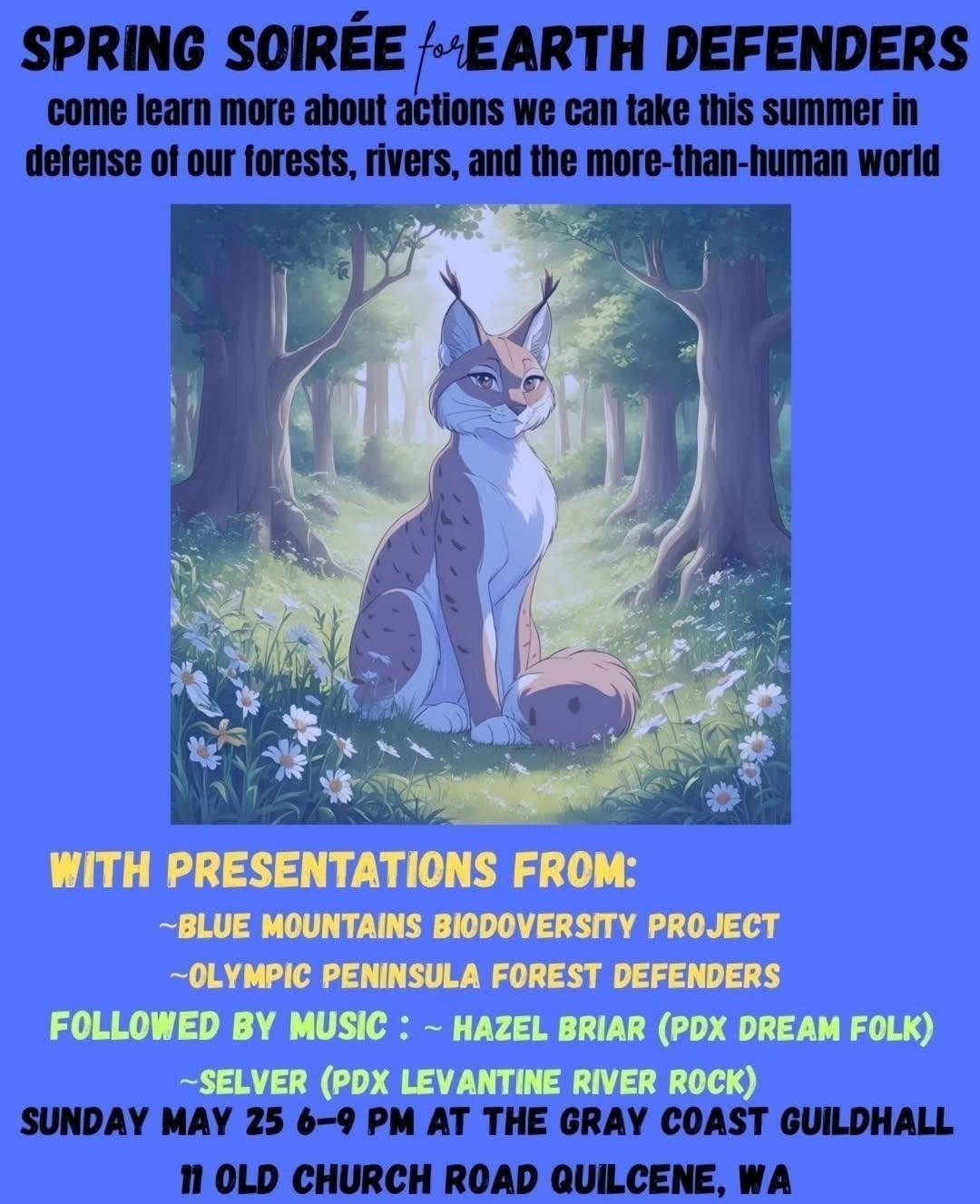What's Next for the Legacy Forest Defense Movement?
Reflections on movement building, direct action, and the future of forest defense

Welcome to Biocentric, a newsletter about sustainability, overshoot, greenwashing, and resistance. It’s written by me, Max Wilbert, the co-author of Bright Green Lies: How the Environmental Movement Lost Its Way and What We Can Do About It, co-founder of Protect Thacker Pass, and organizer with the Community Legal Environmental Defense Fund. If you want to follow, you can subscribe for free. Paid subscribers, in return for supporting this publication and the activism you see here, receive access to private posts which contain behind-the-scenes reports and unreleased drafts.
In this post:
Update from the frontlines
The calm before the storm
Community resistance and resilience
The coming Federal logging boom — thanks to Trump and Biden
What is a “legacy forest”?
What’s at stake
Carbon storage
Actions and events coming up
Ways to get involved and support
Update from the frontlines
Last Tuesday, forest defenders blockaded a road and took to the trees west of Seattle in direct action to halt planned logging.
To prevent logging of this critical habitat, forest defenders placed large debris in the middle of the road. This debris is attached to a climber who is suspended above on a “dunk-tank” platform in a large tree. If authorities attempt to remove the road debris, the platform will drop, risking a 100-foot fall for the climber.
The forest they’re defending is Washington State land, located in the Elwha River Watershed, just outside the small city of Port Angeles. The Elwha River is famous for a dam removal project that was completed in 2014, opening up 70 miles of pristine salmon and steelhead habitat inside Olympic National Park, habitat which had been lost to the fish for a century.
The timber sale the blockade is currently obstructing, known as "Parched," is currently under litigation by the Earth Law Center and Legacy Forest Defense Coalition.
A Clallam County Judge issued a temporary restraining order on May 7th in response to a request by the groups in the lawsuit, temporarily pausing the logging until an injunction can be heard later this month. Community members have vowed to keep the blockade going until the sale is permanently protected, and have highlighted that the restraining order could be lifted at any moment.
A petition — started by members of the Lower Elwha Kallam Tribe urging that the watershed be protected — has been signed by over half of tribal members, as well as being widely supported by local residents, and has garnered over 7,000 total signatures.
According to the blockade support team:
Today is the 7th day of no logging activity in the Parched timber sale area thanks to the tree-sitter and all of their supporters. It takes a whole community to protect the forest, and that community is showing up beautifully.
The sitter is doing well! We have had way less cop presence and folks have been able to walk up often to visit. There is a Temporary Restraining Order in place preventing logging, but we are hoping that our continued occupation and presence both safeguards against any potential decision that is made to overturn the TRO and furthermore encourages completely canceling the Parched timber sale, pausing all Elwha watershed logging, and ending all mature and old growth logging in western WA!
"I'm not going anywhere," said Red Breasted Nuthatch, the tree-sitter, who is using an alias to protect their identity. "Our new lands commissioner, Dave Upthegrove, promised to protect mature forests; we are here to help him keep his promise.”
Asked about their well being on May 13th, Nuthatch replied:
"I'm just chilling. Listening to birds, squirrels, and chipmunks. Chatting with the occasional supporter who walks up the road for a visit. Warm and cozy, having morning coffee at my airbntree."
For more updates, read to the end of this piece.
The calm before the storm
At the moment, things seem to be settled at the Parched timber sale. Police have not arrested anyone and only detained one person, just as the blockade was launched on last week (they were later released and have not been charged).
There is a moment like this that often comes in direct action campaigns; a moment when it is easy to get complacent, when it is comfortable to believe that the new status quo is that the blockade will be allowed to remain in place and people will be allowed to assert their support for the blockade without consequence.
This illusion is unlikely to last.
When an action like this begins, law enforcement and government agencies are on their heels. They are reacting to our actions. We are determining the field of engagement, the location, the time, and the characteristics of the conflict. But now, that calculus changes. They know where the tree sit is. They know how many people are there. They likely know the identities of many of the people who are involved, and they are no doubt planning a response.
At this time, it is undoubtedly true that state police are meeting with representatives from the Department of Natural Resources, county sheriffs, and other regional law enforcement. They are studying photographs and videos they have taken of the tree sit and the technical apparatus and rope work. They are discussing strategies and tactics for dismantling blockades and treesits with subject experts. They are assembling resources, making a plan, and coordinating their response.
This is when our movements need to become multifaceted. What if other tree sits began to emerge in nearby locations? What if mass protests descended on other sites? What if the treesit came down and then reappeared somewhere else? What if they are forced to continue reacting to us?
In military parlance, this is referred to as getting inside your opponents OODA (observe, orient, decide, act) loop; acting faster than they can react.
What if the state police's resources began to be stretched thin? What if this became a political crisis as a generalized uprising against the destruction of forests across the state began? What if this sparked a movement? This is when our strength becomes political power, when our courage becomes the possibility for real systemic change. and it requires us to be bold.
I need your help. I’ve left all social media to focus my attention on organizing, coordinating resistance actions, and writing. That means I rely entirely on readers like you to share this content online. If you appreciate what you read here, please take the time to share on social media, discussion forums, and in direct messages to friends. Thank you!

Community resistance and resilience
The people of Washington State elected Dave Upthegrove as Commissioner of State Lands because he ran on a platform of opposing logging and protecting these forests. And, Upthegrove has delivered — in part — on those promises, pausing all new timber sale approvals in older forests on state lands. But, he has either been unwilling or politically unable to cancel the sales that were already in progress. He is not all-powerful, and the DNR’s mandate, set by the state legislature, is largely to log and generate revenue from timber.
There are two ways that changes. The first is that enough pressure is brought to bear on the Washington State legislature, through this campaign and others, that it changes the mandate of the DNR to prioritize carbon sequestration and biodiversity over revenue generation. This is not, from my understanding of the situation, politically impossible, Electing Upthegrove may be a step in this direction. But, it is only the first step. And it only effects state forest lands, not the much larger private timberlands, or the federal lands that first Biden and now Trump are working to liquidate.
The second way that changes is this: if the system won’t enforce the people’s will and protect forests, we have to do so ourselves. That can take many forms, but all of them will revolve around disobedience of unjust authority and obedience to higher laws, natural laws. This could involve more treesits, rights of nature legislation (which is a form of collective civil disobedience), the formation of alternatives to industrial capitalism, and generalized rebellion against the unjust structures of existing law.
The pairing of rights of nature and community rights with direct action is particularly powerful, since it combines grassroots democracy with people’s enforcement. It produces both a mandate and the power to make it so. This is powerful, and it relies on different wings of the movement working in collaboration. If you are interested in this approach, please reach out to CELDF.
The coming Federal logging boom — thanks to Trump and Biden
This campaign is important, but it's also just a warm-up.
Washington State and Dave Upthegrove are much more friendly towards protest movements and less aggressively in favor of logging than the federal government under Donald Trump.
On March 1, 2025, Trump signed an Executive Order titled “Immediate Expansion of American Timber Production.” It directs the U.S. Forest Service and Bureau of Land Management to develop plans to streamline permitting, hasten environmental reviews, bypass opposition, and maximize logging across the 187 million acres of forests these agencies manage.
But the problem is not just Trump. The Northwest Forest Plan, which came into effect following a mass uprising by Cascadian forest defenders, is under assault — not just from Trump’s executive orders calling for more logging, but from changes to the plan proposed under Biden. Andy Kerr lays out a strategy to resist this here, and it’s almost certain that direct action will be needed to protect these forests again, just as it was three decades ago.
Prepare yourself.
What is a “legacy forest”?
For more than four years, activists across the Pacific Northwest have been campaigning to protect so-called legacy forests, successfully protecting thousands of acres. But what exactly is a legacy forest?
According to the Center for Responsible Forestry:
Legacy Forests are structurally complex, mature forests. They were often logged prior to 1945, after which began the widespread use of clearcutting with chainsaws, herbicides, and replanting as monocrops. They are critical for biodiversity, water quality, and salmon habitat. They store and sequester vast amounts of carbon at rates unequaled in the world. They are natural forests, not tree plantations, and as such they are more resistant to wildfire.
To classify as a Legacy Forest, these forests generally have the following characteristics:
Pre-1945 origin
Un-planted, naturally regenerated
Structurally complex (different stages of life cycle)
Genetically & biologically diverse
If protected, legacy forests will become Old Growth

What’s at stake
The Parched timber sale is located east of the Elwha River and Highway 101, in the Dry Hill mountain bike area and above the Little River, a tributary of the Elwha River. The sale includes large, mature Douglas fir, western red cedar, grand fir, western hemlock, and big leaf maple. It targets a high-elevation primary forest, on a mountaintop above the Elwha River dam site. Most of the forest originated after a fire in 1880. With units 3 and 6 of the sale have never been logged before, and the rest of the sale area having never been logged by machinery, this 100-year-old forest is developing old-growth characteristics essential to endangered species like the northern spotted owl and marbled murrelet. An imperiled flower, whipplea modesta, also makes its home here.
A licensed independent engineering geologist, Glen G. Wade, reviewed the landscape during the SEPA review noting that logging would increase runoff in an area already threatened by deep-seated landslides "posing direct risks to nearby residences, Little River Road, and the Little River itself." Additional concerns have been raised about impact of logging on fragile salmon runs. "Parched" and other DNR sales are very near the site of the recently removed dam, where state and federal governments invested more than $338 million in river and salmon restoration.
Since 2022, Port Angeles City Council has raised serious concerns about logging the Elwha River watershed, as it is the sole source of drinking water for Port Angeles. The city claims their efforts for collaboration and dialogue with the DNR have been resisted or outright denied.
As the Seattle Times’ Lynda Mapes wrote last Thursday, reporting on the action:
“…as more trees fall and climate change challenges the health of forests — and the rivers those forests protect — logging in the Elwha has been particularly controversial. It was there that Congress spent more than $350 million to take down two hydropower dams to revive legendary fish runs in the Elwha — a recovery that is just beginning to take hold more than a decade after the last dam came down.
Logging can increase sediment in streams. Cutting the canopy can raise stream temperatures. Cutting mature forests and replanting with young trees depletes stream flows and the effect lasts for decades. All of these things have happened on the Olympic Peninsula for many years, stressing salmon and steelhead populations.

Carbon storage
The Washington State Department of Natural Resources has been auctioning these forests off to logging companies with virtually no oversight, public input, or media attention.
This is why frontline forest defenders and the groups litigating to protect these forests in the courts (such as the Legacy Forest Defense Coalition, LFDC, and Earth Law Center, ELC) are all independently calling for Washington State to permanently protect legacy forests on State land for carbon sequestration and biodiversity.
These large and maturing forests are incredibly important for carbon storage. Recent research shows that, in the western United States, trees larger than 50 cm in diameter comprise ~75% of the total carbon stored in live trees, and the top ~2% largest trees account for 75% of the live tree carbon storage.
Other research has found that Pacific Northwest temperate rainforests store more carbon than “any other type of vegetation, anywhere in the world.”
In contrast, according to Dr. Dominick DellaSalla, a scientist who served for two terms on Oregon Governor Kate Brown’s Forest Carbon Task Force reporting to the governor, legislature, and Oregon Global Warming Commission on forestry emissions and carbon accounting methods, after logging “on average roughly 80% of the original carbon stored in trees is released into the atmosphere… with much of that released within one or two years of logging.” This, plus the emissions from trucks and other equipment used in logging, makes timber “the second most carbon intensive industry in the state.”
The LFDC states that: “[The Washington Department of Natural Resources, or DNR] made a commitment in 1997 to restore old growth forests across 10-15% of state forestlands in Western Washington. DNR has completely ignored this commitment. Instead, the agency has been aggressively logging the very forests it needs to protect to meet its targets.” According to Joshua Wright, an organizer with the group, the revenue that logging these forests produces for the state and local tax districts is a minuscule percentage of the state budget.
Actions and events coming up
👉 Mark your calendars for this info sharing event/meet & greet for local land care and defense projects coming up next weekend in Quilcene.
🗓️ DATE: May 25
🕕 TIME: 6-9PM
📍 PLACE: Gray Coast Guildhall, 11 Old Church RD, Quilcene
Ways to get involved and support
Show up. 🏕️
Ground support is asking people to come and camp! The camping area is beautiful and secluded with a view of the mountains. We had a fire last night and it was lovely! There’s plenty of extra food, even some extra camping gear. Folks need to bring as much water as they can because there is no close source. It is a priority to get more people on the ground. Remember, we keep us safe, and a strong ground support presence is crucial to the longevity of this blockade. The more the merrier, come on up, bring your gear, and stay awhile. Get to know the forests that you’re helping to protect! No contact needed, but bring a buddy, make sure you know where you're going, and have an emergency back-up plan! DNR police have been intermittently present at both the gate off of Walkabout Way and at the tree-sit. Both Saturday’s march and the march last Thursday proceeded past the police without interference. However, this is not a guarantee of future police behavior.
“We had a chill and beautiful evening in a concealed clearing up the road surrounded by the rising full moon, old growth Douglas Fir, the Olympic glaciers, and a great view of the road and treesit below. At noon today May 11, 2 DNR trucks and 1 DNR white utility van were at the base of the treesit. However we were able to walk past them without being stopped. With so many people coming on backroads to the site and then being witnessed walking out through the locked gates, the illusion is created that we are all hiding out in the woods in support. Which we are!
🧭 Here are some useful coordinates to help you get to the site: Remember that you can also download the Avenza mapping app and add the free map "Elwha, WA" to easily see all backroads in and out to the treesit.
📍Tree sit: 48.0840055, -123.5239930
📍Yellow gate with cops: 48.0994418, -123.5159300
📍Parking at gas station: 48.1026172, -123.5133836
Join the Pressure Campaign. ☎️
Remember that you can still call Commissioner Upthegrove at 360-902-1000, extension 4, and amplify the demands of the blockade:
👉 Re-open the Dry Hill recreation area
👉DNR cops out of the area
👉Immediate cancellation of the "Parched" Timber Sale.
👉A pause on all logging in the Elwha watershed
👉A permanent ban on logging the remaining mature forests in western Washington
Sign the Petitions. 🖊️
Petitions rarely change the world. But alongside movement building, pressure campaigns, direct action, lawsuits, and more, they add popular weight to our mandate. There are two petitions related to this issue:
Make a Donation. 💸
Monetary donations can be directed to this Gofundme.
Liaise with community members
👉 REQUEST FOR ASSISTANCE WITH mountain bike race liaising this weekend:
🚵♀️ We're hoping to have folks posted up at the entrance to the logging road this weekend fri-sun all day. There's a mountain bike race at our site 🙃 and we want to support folks in getting around and maintaining relationships with this group of folks who also uses the trails and (hopefully) lives the forest! A buddy pair for each day would be ideal.
Bring Supplies. 🎒
Ground supporters and the sitter have asked for the following. You can reach out to 360-454-2803 to coordinate donation delivery/pickup.
An eBike or dirt bike to lend or donate
A big pot
Brightly colored flags
Buckets with lids
Climbing gear, including pulleys, carabiners (D autolocks, steel oval screw gates, large steel links) webbing, 11mm static rope, p-cord, accessory cord)
Power banks & solar panels
Silver duct tape for labeling buckets
Heavy duty tarps
5-7 gallon water jugs
Sleeping bags and lightweight rain gear
Thermals, especially wool
Food requested includes: bone broth power, protein bars/protein powder, dehydrated meals, electrolytes, high quality trail mixes
PSA: after being forced to dismantle our protest camp at Thacker Pass in 2021 when we were fined $50,000 and threatened with worse by the Federal Government, we ended up with 4,000 pounds of supplies and food we had to deal with, much of which we donated to local food banks, mutual aid groups, and other campaigns. Similar overload of supplies occurred at Standing Rock, where massive quantities of material posed a major logistical and garbage-management challenge for organizers in the aftermath. Therefore, please ensure that supplies are actually needed before leaving them with organizers in a situation like this.









